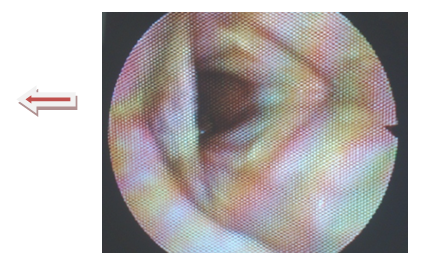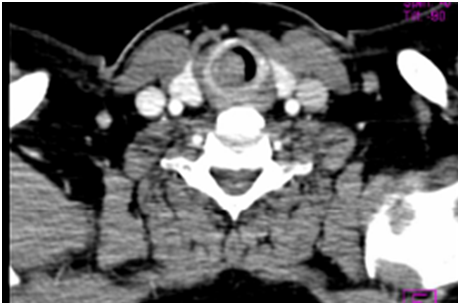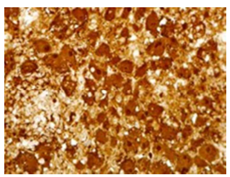Journal of
eISSN: 2376-0060


Case Report Volume 3 Issue 3
1Specialist, Department of ENT, Al Jalila children specialty hospital, Dubai, UAE
2Consultant, Department of ENT, Al Qasimi hospital, Sharjah, UAE
3
4Senior specialist, Department of Respiratory and Sleep medicineRashid hospital Dubai
Correspondence: Deepa Vats, Specialist ENT, Department of ENT, Al Jalila hospital, Dubai UAE, Tel -558824335
Received: May 29, 2016 | Published: June 13, 2016
Citation: Vats D, Reda AIA, Houli EA, et al. Rosai-dorfman disease presenting as isolated subglottic mass- an extremely rare presentation. J Lung Plume Respir Res. 2016;3(3):92–94. DOI: 10.15406/jlprr.2016.03.00087
We report an unusual case of Rosai-Dorfman disease (sinus histiocytosis) with isolated subglottic involvement leading to progressive dyspnea and airway obstruction. We emphasize that Rosai-Dorfman disease should be considered as a differential diagnosis in patients who present with a recurrent inflammatory mass lesion of the larynx.
Keywords: rosai dorfman disease, sinus histiocytosis, subglottic mass
Rosai-Dorfman disease, or sinus histiocytosis with massive lymphadenopathy, is a disease primarily involving the lymph nodes.1 However in approximately half of cases it may present as multifocal and multisystem condition simultaneously involving extra-nodal sites and in 23% cases isolated extra-nodal Rosai-Dorfman disease can occur.2 The common extra-nodal sites are skin, eye, paranasal sinuses, genitourinary system, CNS, bone, breast, soft tissues and thyroid.2–6 We are describing a case of Rosai-Dorfman disease presenting as isolated subglottic Mass with the chief complaint of progressive dyspnea.
A 45yr old male ex-smoker with history of progressive dyspnea over 3-4months presented to ER for evaluation. Patient was a known case of diabetes mellitus, hypertension optimized on the medicines. There was no any other significant past medical or surgical history. There was no history of any constitutional symptoms (viz fever, weight loss). Systemic Examination was unremarkable for any evidence for subcutaneous or lymph node involvement. His blood tests were within normal limits including CBC, LFT, RFT, CRP and ESR.
Urgent laryngoscopic examination revealed a solid polypoidal mass approximately 3cm in size in the subglottic region almost blocking the subglottic airway and moving up and down with the respiration (Figure 1). CT scan of the neck with contrast revealed a well-defined soft tissue density mass lesion measuring approximately 3cm ×3cm×2.5cm in CC, AP and transverse diameters arising in the right subglottic region breaching the right side of the cricoids cartilage pedunculated from the posterior wall encroaching upon and compromising the lumen of the lower part of the larynx and upper trachea causing more than 50% luminal narrowing of the airway and pushing the right thyroid lobe laterally exhibiting slight contrast enhancement (Figure 2). There was no evidence of pathologically vascular enhanceing lesions/ thyroid nodule/cerival lymph node involvement or paraspinal soft tissue mass. Hence considering a mass lesion direct laryngoscopic& biopsy was done under GA with tracheostomy. Histopathological examination revealed inflammatory lesion with numerous S100 positive histiocytes like cells and predominant emperipolesis diagnostic of Rosai-Dorfman disease. Immunohistochemistry stains like CKAE1/AE3 were negative in subepithelial area, and CD1a and Melan was also negative. Vimentin and CD68 were positive in histiocytes like cells confirming the diagnosis of Rosai-Dorfman disease and excluding other diagnosis (Figure 3).

Figure 1 Solid polypoidal mass approximately 3 cm in size in the subglottic region almost blocking the subglottic airway.

Figure 2 CT Scan Neck (with contrast) well defined soft tissue density mass lesion measuring approximately 3cm ×3cm × 2.5cm in CC, AP and transverse diameters arising in the right subglottic region breaching the right side of the cricoid cartilage pedunculated from the posterior wall encroaching upon and compromising the lumen of the lower part of the larynx.

Figure 3 Histopathological examination revealed inflammatory lesion with numerous S100 positive histiocytes like cells and predominant emperipolesis.
Abdominal ultrasonography, thorax and cranial CT images, and technetium-99 bone scans were normal.
Rosai-Dorfman disease is a rare, idiopathic, nonneoplastic, lymphoproliferative disorder classically characterized by bilateral cervical lymphadenopathy with fever, leukocytosis, increased erythrocyte sedimentation rate and hypergammaglobulinaemia.2 The extranodal sites include skin, soft tissues, respiratory system, genitourinary system, bones, CNS, orbit, thyroid and breast2–6 in about quarter of patients isolated extra-nodal disease occurs. It can occur in children and in adults and mean age of incidence is 20.6years with Male to female ratio is 1.4:1.2,3 Patients with soft-tissue involvement tend to be older than patients with other extra-nodal sites.3
The clinical & radiological features may vary depending on the site involvement. The radiological imaging is confounding because of the broad differential diagnostic possibilities and biopsy of the mass is highly recommended.
The gold standard for the diagnosis of subglottic Rosai-Dorfman disease is biopsy either through direct laryngoscopy or USG guided fine needle aspiration.7 The histological appearance is characteristic regardless of the site of occurrence with pathologic hallmark of large histiocytes with abundant pale cytoplasm, round vesicular nuclei and lymphocyte phagocytosis or emperipolesis (Figure 3) (Figure 4). Extranodal cases can be diagnosed easily by doing nodal biopsy. However, in cases of isolated extra nodal site the diagnosis could be difficult and a greater number of characteristic histiocytes with emperipolesis are required for diagnosis to be confirmed. Immuno-histochemical diagnostic depends on cytoplasmic positivity of histiocytes for S-100 protein. In our patient diagnosis was made by laryngoscopic excisional biopsy with simultaneous exclusion of malignancy and CT was done to evaluate the extension of the mass in the surrounding structures.
The aetiopathogenesis and natural history of Rosai-Dorfman disease are unknown. An immunological phenomenon has been postulated causing benign or reactive proliferation of histiocytes with emperipolesis showing spontaneous regression.8,9 The treatment options range from surgery, radiotherapy and steroids to chemotherapy or spontaneous regression and the treatment options depends upon the severity of airway obstruction. In our case we did the tracheostomy to relive the obstruction caused by the mass and patient had significant improvement in his symptoms. After that patient went to his country for further management with no follow up despite our best try to contact him.
Considering the rarity and very low index of suspicion of the subglottic Rosai-Dorfman disease the diagnosis could be missed easily with significant consequences. Hence we recommend that Rosai-Dorfman disease should be considered as a differential diagnosis of granulomatous infection, pseudogranulomatous lesion and malignancy in patients who present with a recurrent inflammatory mass lesion of the subglottic region or larynx and Laryngoscopy should be performed in cases presenting with refractory asthma or unexplained progressive dyspnoea to exclude Rosai-Dorfman disease.
Dr Deepa vats collected the case history, literature review, Dr Ibrahim and Dr Eman contributed for the manuscript review and suggestion, Dr Mayank vats helped in manuscript preparation and review and suggestions.
The author declares no conflict of interest.

©2016 Vats, et al. This is an open access article distributed under the terms of the, which permits unrestricted use, distribution, and build upon your work non-commercially.